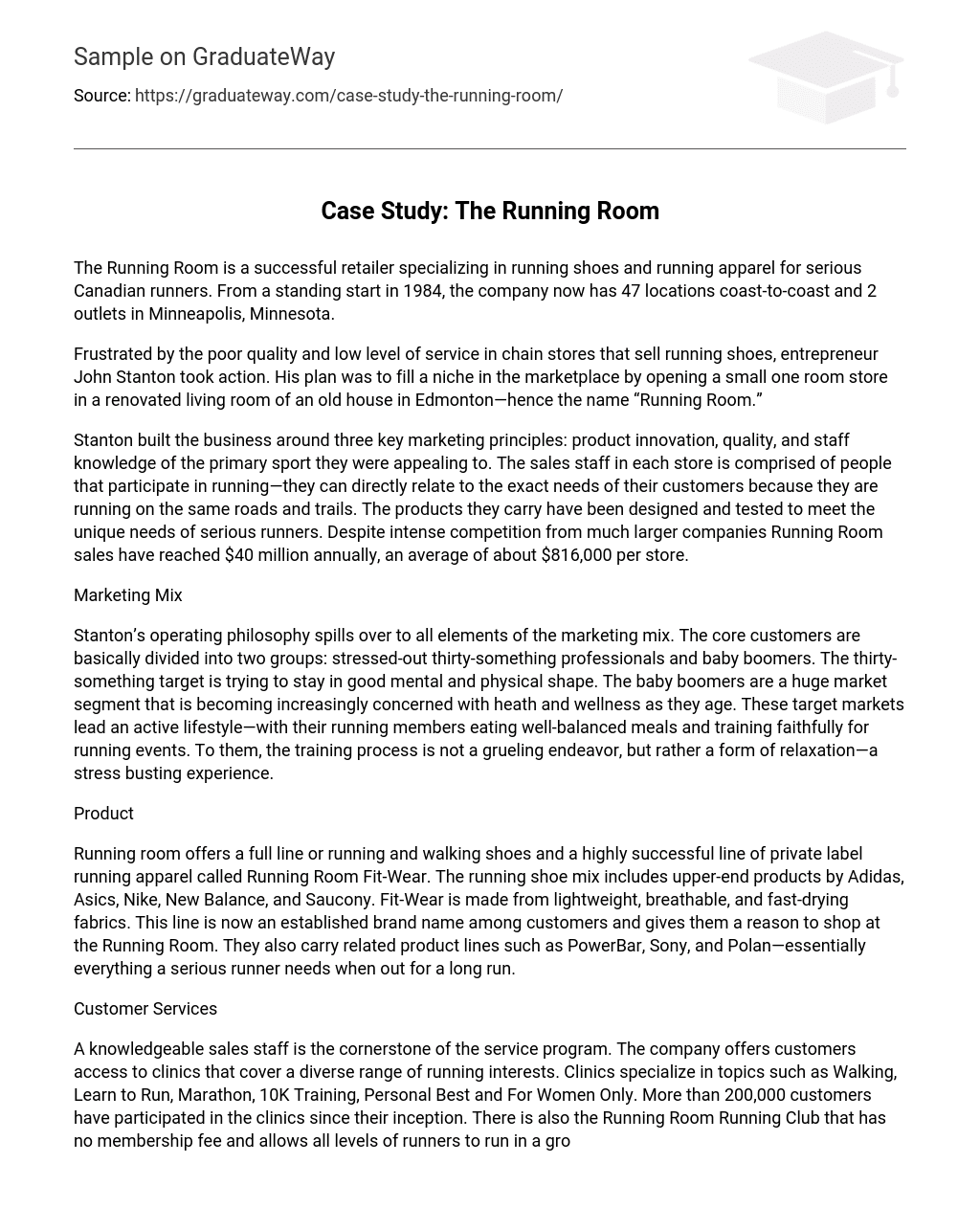The Running Room is a successful retailer specializing in running shoes and running apparel for serious Canadian runners. From a standing start in 1984, the company now has 47 locations coast-to-coast and 2 outlets in Minneapolis, Minnesota.
Frustrated by the poor quality and low level of service in chain stores that sell running shoes, entrepreneur John Stanton took action. His plan was to fill a niche in the marketplace by opening a small one room store in a renovated living room of an old house in Edmonton—hence the name “Running Room.”
Stanton built the business around three key marketing principles: product innovation, quality, and staff knowledge of the primary sport they were appealing to. The sales staff in each store is comprised of people that participate in running—they can directly relate to the exact needs of their customers because they are running on the same roads and trails. The products they carry have been designed and tested to meet the unique needs of serious runners. Despite intense competition from much larger companies Running Room sales have reached $40 million annually, an average of about $816,000 per store.
Marketing Mix
Stanton’s operating philosophy spills over to all elements of the marketing mix. The core customers are basically divided into two groups: stressed-out thirty-something professionals and baby boomers. The thirty-something target is trying to stay in good mental and physical shape. The baby boomers are a huge market segment that is becoming increasingly concerned with heath and wellness as they age. These target markets lead an active lifestyle—with their running members eating well-balanced meals and training faithfully for running events. To them, the training process is not a grueling endeavor, but rather a form of relaxation—a stress busting experience.
Product
Running room offers a full line or running and walking shoes and a highly successful line of private label running apparel called Running Room Fit-Wear. The running shoe mix includes upper-end products by Adidas, Asics, Nike, New Balance, and Saucony. Fit-Wear is made from lightweight, breathable, and fast-drying fabrics. This line is now an established brand name among customers and gives them a reason to shop at the Running Room. They also carry related product lines such as PowerBar, Sony, and Polan—essentially everything a serious runner needs when out for a long run.
Customer Services
A knowledgeable sales staff is the cornerstone of the service program. The company offers customers access to clinics that cover a diverse range of running interests. Clinics specialize in topics such as Walking, Learn to Run, Marathon, 10K Training, Personal Best and For Women Only. More than 200,000 customers have participated in the clinics since their inception. There is also the Running Room Running Club that has no membership fee and allows all levels of runners to run in a group setting twice weekly—a social experience.
Marketing Communications
The company does a modest amount of advertising in local markets to generate initial store awareness and to promote the product lines they carry. Once awareness is established public relations plays a key role in building store image. Each year, Running Room sponsors, helps organize, or promotes more than 400 walks, runs and events that raise funds for charities and non-profit organizations. The company maintains an informational Web site that promotes the store, running and walking events and opportunities for the public at large to pursue.
Price
Due to the unique needs of the clientele, only high quality, reliable shoes are stocked. As a result, the price points are at the upper end of the price spectrum. Serious runners and walkers will pay for a good quality shoe. The brands carried and the varieties available within brands are more important issues than price.
Distribution and Environment
The stores are modest-looking 2,000 square foot rooms usually located in strip malls or on the main street of smaller communities. There are no fancy fixtures, only a wall-display of shoes, circular display racks or wall racks for clothing accessories and a wall of pegs that merchandise running related products such as socks, head bands and nutritional supplies.
Competition
The Canadian sporting goods market is very competitive. The Forzani Group Limited is the market leader operating under a variety banners: Sport Chek, Forzani’s, Sports Experts, Coast Mountain Sports and Sport Mart. The multi-banner concept provides the largest group of Canadian customers a collection of sporting goods at all price points. Serious runners don’t take these stores seriously. Other competitors include Athlete’s World (owned by Bata) and Foot Locker. Foot Locker is the number one athletic footwear retailer in the Unites States. These retailers are more style conscious—their product lines appeal more to recreational athletes, people who want good value at a lower price point, and people who simply want to wear the latest styles in athletic wear.
Primary competitors tend to be small independent outlets that exhibit local market strength based on longstanding customer loyalties. Among these competitors are Runners Choice (Kingston), Running Free (Barrie), The Running Factory (Windsor) and The Runners Shop (Toronto).
Present Situation
Stanton has a preference for locating stores in smaller markets (refer to Figure 1 for present store locations) and has concluded that further growth prospects in Canada are marginal at best. He wants to pursue opportunities in the United States. He prefers smaller markets where only one or two stores are needed in order to establish a presence. Canadian expansion was systematic with each new location being paid for out of cash flow generated by existing stores. The company does not owe any significant debt. A typical Running Room costs about $200,000 to open according to Stanton.
The Challenge
Considering the geography of the U.S. and the criteria for location that Stanton seems to prefer, what strategies should be employed to enter that market and how fast should they proceed with entry in the market?
Source: OCMC





